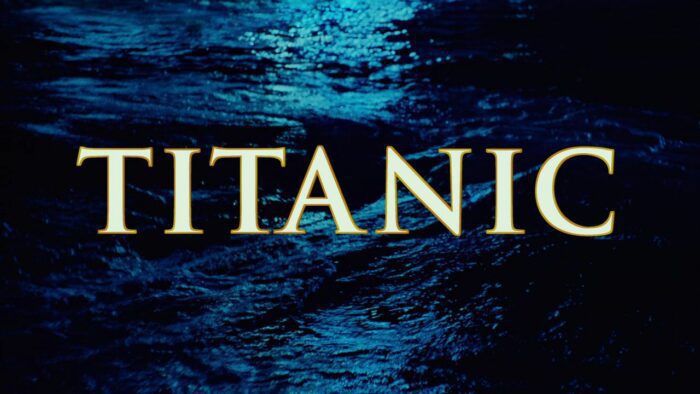
Whether we remember (or were alive even for) the innocent pre-9/11 world of the premillennial, successful, and optimistic 1990s or not, Titanic stands as the quintessential cinematic phenomenon of an entire generation of moviegoers who witnessed its power, wonder, and success in 1997 and 1998. For older audiences, director James Cameron’s Titanic rivaled Gone With the Wind‘s romantic Hollywood nostalgia for a different era and extended the mythology towards the 20th century’s most famous tragedy. For new and uninformed viewers then, the film brought the old legend to life and stoked an emotional windfall that has never been seen in movies before or since.
You knew where you were when you saw Titanic, who you were with, and exactly how you felt about the experience afterwards. I know I do. I was an 18-year-old college freshman in 1997. I saw it solo, with friends, and even took two different dates to see the movie.
Opening to a modest $28.6 million during the third weekend of December 25 years ago, the movie generated unheard of repeat business compared to the front-loaded $150+ million blockbuster openings of today. “Leo-mania” and the movie’s event-level special effects created viewing parties and kept the audience coming back again and again. Titanic was the event movie of its decade.
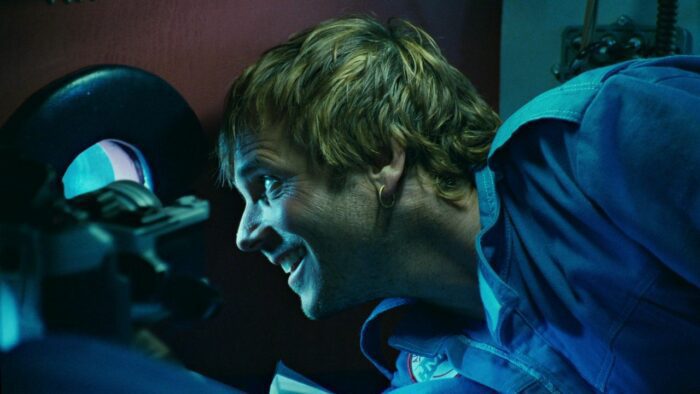
Titanic, unlike its titular cruise liner, was unsinkable at the box office, where it remained number one for a record 15 straight weeks until Lost in Space knocked it off its perch in April of 1998. The movie never grossed more than $13 million any day of its run, yet it stayed in theaters until the first week of October 1998 after it crossed $600 million in domestic gross. In total with foreign earnings, Titanic was the first film to ever cross the billion dollar mark. It has since crossed the $2 billion level.
For a dozen years, when it was bested by James Cameron’s own Avatar, it was the highest grossing movie in history. Its accompanying orchestral score soundtrack was the #1 Billboard album for 16 straight weeks and sold over 30 million copies worldwide. In March of 1998 for the 70th Academy Awards, Titanic tied the records for most Oscar nominations (14) and wins (11). With that resume and more, “phenomenon” has quickly becoming an understatement of a label.
In 2012 and timed for the 100th anniversary of Paramount Pictures and the ship’s fateful maiden voyage, Titanic was meticulously re-mastered for a 3D re-release to movie theaters. James Cameron poured over 60 weeks and $18 million into the 4K resolution and 3D conversion process, even going so far as to accurately update the stars and their position in the sky to match April 1912.

In reflecting on how much of a phenomenon Titanic turned out to be, to me, the most fascinating aspect of its success was its universally predicted failure before it came out. Delayed nearly six months from its original 1997 Fourth of July weekend release date and bloated to a historic $200+ million budget (at the time, the most expensive movie ever made), all movie insiders talked about that summer and fall was measuring how big of a costly flop this movie was going to be for James Cameron and the co-production of 20th Century Fox and Paramount Pictures.
Movie pundits, who hadn’t even seen the movie, didn’t see the potential. They instead saw Waterworld, the notoriously water-logged and expensive 1995 debacle, happening again two years later. What was perceived as an expensive glamor project by a furiously difficult, temperamental, and driven director ended up being worth every penny, past and present.
The money spent creating Titanic gives the film a level of authentic detail, none greater than the massive 90% scale model set of the ship, built off of the original blueprints in a 17 million gallon tank off the coast of Mexico (now known as Fox Baja Studios). For the decadent interiors, Cameron and his production design crew of set decorators and designers endlessly researched and recreated the original and vintage designs, costumes, accessories, patterns, and construction for everything from the deck chairs to the plates and silverware. Very little was left off in historical accuracy.
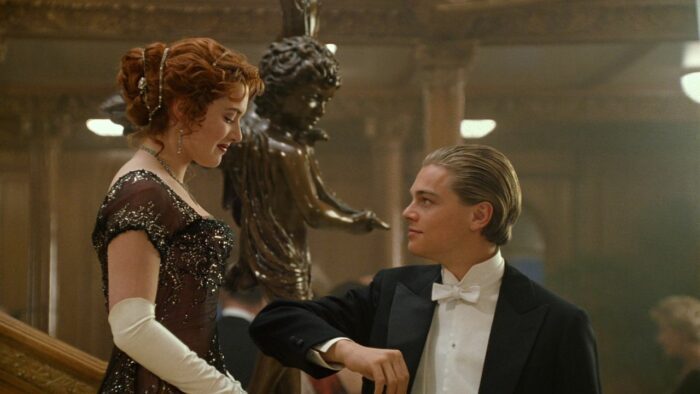
Finally, going to a degree of authenticity that no other filmmaker would dream of, Cameron spent two years diving with submersibles over 13,000 feet down in the icy North Atlantic to shoot footage of the ship in its final resting place (where he would return in 2001 for the 2003 documentary Ghosts of the Abyss). Whatever couldn’t be recreated after that, groundbreaking digital effects did the rest. The technological achievement of the film was unparalleled at the time and it shows on screen.
Framed by the present day scenes of a treasure diver (Bill Paxton) researching the RMS Titanic wreckage for a famous lost blue diamond necklace, “The Heart of Ocean,” the film allows a 101-year-old fictional survivor, Rose DeWitt Bukater (former Golden age starlet and Academy Award nominee Gloria Stuart), to tell her story of the ship’s maiden and only voyage. Portrayed in her youth by the Academy Award nominee (and future 2009 winner) Kate Winslet, Rose is a daughter of high society betrothed to a snobby and arrogant steel baron heir, Cal Hockley (the under-appreciated Billy Zane). Her first-class ticket to board the greatest ship ever built is assured, as opposed to the last-minute third class place won by the charismatic America castoff, Jack Dawson (Leonardo DiCaprio, another future Oscar winner, hot off his Romeo + Juliet heartthrob status) in a game of poker.
Along the way, through both characters, we learn the vast differences between classes on the ship, the way things were back then, and many historical figures of the voyage, including Molly Brown (Oscar winner Kathy Bates), Captain Edward John Smith (Lord of the Rings ensemble member Bernard Hill), White Star owner (Anaconda’s Jonathan Hyde), ship architect Thomas Andrews (Victor Garber of TV’s Alias), John Jacob Astor IV (soap star Eric Braeden), and other millionaire passengers. Feeling trapped in a loveless engagement on her way back to America, she is tempted by suicide only to be talked out of it by Jack, in the right place at the right time. Defiantly against their class differences, the two become inseparable and fall hopelessly in love. That is, until history takes over and our characters bear witness to the “unsinkable” Titanic‘s tragic encounter with an iceberg in the North Atlantic.

For as opulently as the movie introduced us to the grandness and luxury of Titanic, James Cameron takes us through its sinking and destruction in equally breathtaking detail when the dynamic Russell Carpenter cinematography and Digital Domain visual effects take over. It is during this final two hours of the movie, that the legend of Titanic grows to a new level, both inside and outside the world of cinema.
Those who know the story’s history have heard and read of the tales of heroism and chivalry surrounding the tragedy. We know the shortage of lifeboats, the legendary survivors and deaths, and the myth of the band playing until the very end. However, it is very poignant to see those tales and moments played out on-screen the way Cameron presents them, especially when James Horner’s Oscar winning score begins to sink in more and more. We know how the movie is going to end, but, thanks to our aspiring young lovers, we are constantly rooting for rewritten history to step in and grant a happy ending. Through tragic emotion and awe-inspiring spectacle, the film grabs us and holds us during its climax as few movies ever have, and possibly ever will. The resonating power of it all follows you, and even haunts you, after the movie ends.
Titanic is not the first movie to have the poor guy fall for the rich girl or vice versa. I mean, come on, Aladdin does it too, but you don’t see people bawling their eyes out over Aladdin. You don’t see the stock of Kleenex double overnight. It doesn’t take movies to remind us that love doesn’t have socioeconomic limits, but it’s something we enjoy watching and rooting for. Society’s discretion may try to separate situations and hold love apart, but, of course, love knows no bounds. For as much as Titanic brought history to life in amazing cinematic detail, it’s the love story that kept bringing people back for more.
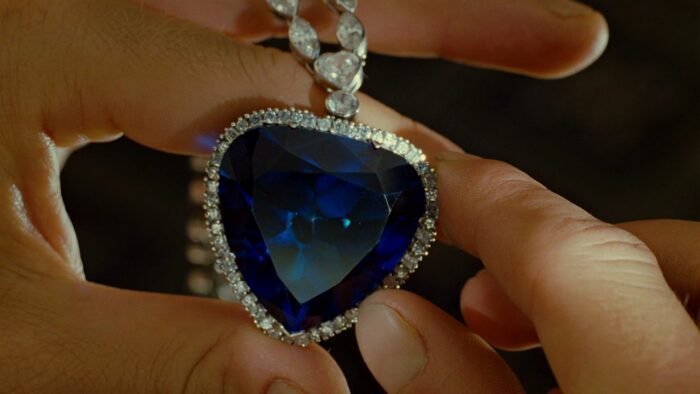
While the fictional love story is what gave Titanic its massive box office success, one cannot leave out the respectful tone the film takes to honor the 1912 tragedy that claimed over 2,200 lives. The realism emanating from the heroism, chivalry, courage, and resolve of strangers and ordinary humble people who know they are going to die pulls heartstrings and hits just as hard as Jack and Rose’s piece.
In fact, the hardest instant cry moment occurs not watching the Jack/Rose climax, but on the vertical angle montage shot watching an older couple laying in their bed together, locked in tight embrace, as the water rushes in, while Horner’s score eulogizes the moment in the background. Fearful, yet at peace with their fate, that moment is equally beautiful as it is frightening. Much like Bill Paxton’s character’s growth to look past the treasure and see the real tragedy, the emotion of the history and human loss involved is genuine, shaping our perspective if we are respectful enough to let it in.
In 25 years, the movie’s appeal has aged a little, likely replaced by teenage crushes on superheroes and shortened attention spans scrolling through streaming channels and viral videos, but Titanic’s sheer scale, power, and wonder hold up. Yes, the Celine Dion song is overplayed and a little cringe-inducing, as is some of the film’s dialogue. Sure, people now make fun of the tissue parties of teenage girls and the frailty of men who cry with them. There’s even DiCaprio still getting grilled today at press junkets about how Jack could have fit on that floating door.
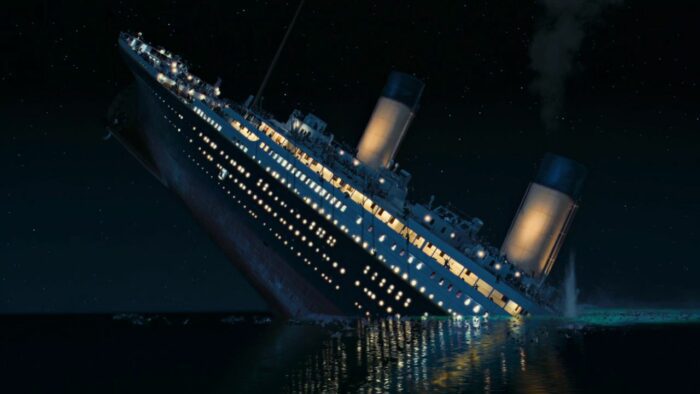
The performances deserve to be celebrated with power. Gloria Stuart’s sweet older Rose will always have a special place in our movie hearts. Her present-day scenes really tie the movie together and connect the history. Of course, though, it’s all about Jack and Rose. Titanic easily catapulted both Kate Winslet and Leonardo DiCaprio’s careers, and neither one has wasted their talent in the years since.
DiCaprio has gone on to be one of this generation’s best lead actors, if not the best outright, for his winning work and A-list director. Filmed when he was 22, his heroic exuberance and spirit as Jack was, as Roger Ebert said, “captivating.” It took a few years, but the “Leo-Mania” hype was warranted.
Winslet, who endlessly pleaded for the part of Rose over the likes of Gwyneth Paltrow, Scent of a Woman‘s Gabrielle Anwar, and DiCaprio’s Romeo + Juliet co-star Claire Danes to Cameron, has quietly become her generation’s Meryl Streep with her dramatic and powerful presence in prestigious films. As Rose, Kate (who was also 22 at the time), displays the poise, vulnerability, and luminous beauty necessary to be an unbridled woman of passion and cardinal object of desire.

Their chemistry makes the movie’s romance effective. Kate and Leo, as a testament to both the film’s huge success and their own smart choices as actors, have intentionally avoided romantic roles since Titanic. In fact, to see the two of them reunited as co-stars again in 2008’s Revolutionary Road, directed by Winslet’s then-husband Sam Mendes of American Beauty fame, about an unhappily married couple in the repressive 1950s is almost eerily uncomfortable to watch after identifying the two of them with Titanic.
If the romantic drama doesn’t get you, the spectacular visual effects ought to do the trick. Watching this Titanic, one can appreciate the details and great craftsmanship put into every scene and shot. The movie is a technical marvel on every level. The sound work is exceptional from the largest boom to the smallest movement. The Digital Domain visual effects fill in the world already occupied by the extremely detailed and aforementioned set and production design.
By definition, hubris means “extreme pride or arrogance.” That word applies to Titanic, both in front of and behind the camera. On screen and in the story’s history, the White Star owners and creators of the great ship possessed this flaw in believing the ship to be “unsinkable” and ignoring safety protocols. Behind the camera, James Cameron, with his autocratic manner, has long been a notoriously difficult director to work with. He pushes his ideas through, no matter the cost or risk of failure. While Titanic and Avatar after it were huge hits, he’s burned a few bridges with his “I’m the king of the world” pride. Titanic, with its immense scale, without a doubt, raised the game and the bar for grand Hollywood spectacle, right there with Ben-Hur, Lawrence of Arabia, and Gone With the Wind that came before it.




